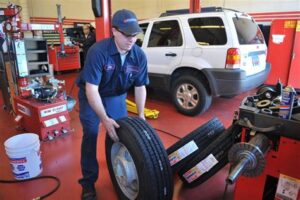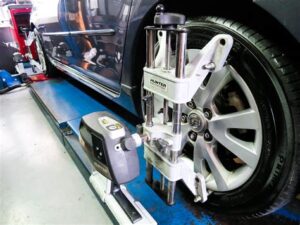Discover the significance of wheel alignment, its effects on lowered cars, challenges faced, and custom solutions for optimal alignment benefits.When it comes to enhancing the performance and aesthetics of a lowered car, one aspect often overlooked is wheel alignment. Achieving the perfect stance can dramatically transform the look and handling of your vehicle; however, lowering a car can significantly affect its alignment. This blog post delves into the crucial importance of maintaining proper wheel alignment for lowered cars, exploring how modifications impact alignment and the challenges that arise from these changes. We’ll discuss custom solutions designed specifically for lowered vehicles and highlight the benefits of keeping your alignment in check. Whether you’re a seasoned car enthusiast or a new owner looking to make modifications, understanding the intricacies of wheel alignment will ensure you enjoy a smooth and safe driving experience while maximizing your vehicle’s potential.
Importance of Wheel Alignment
Wheel alignment is a crucial aspect of vehicle maintenance that is often overlooked by car owners. Proper alignment ensures that your vehicle’s wheels are set to the manufacturer’s specifications. This not only enhances the overall driving experience but also prolongs the life of your tires.
Misalignment can lead to various issues, including uneven tire wear, poor handling, and compromised safety. It’s essential to understand that even a slight misalignment can affect the performance of your vehicle. Regular wheel alignment checks are vital, especially for those who drive frequently or have modified their cars for lowered stances.
Moreover, properly aligned wheels contribute to better fuel efficiency. When your wheels are aligned correctly, your vehicle does not have to work as hard to move, leading to improved gas mileage. In summary, maintaining wheel alignment is not just about comfort and safety; it directly affects your car’s performance and efficiency.
Effects of Lowering on Alignment
Lowering a vehicle can drastically alter its geometry, which in turn affects its wheel alignment. When a car is lowered, the angles at which the wheels sit can change, leading to a host of alignment issues that can impact handling, tire wear, and overall safety.
One of the primary effects of lowering is the reduction of suspension travel. This means that the suspension cannot absorb bumps and other road imperfections as effectively as it could at a higher ride height. With less travel, the vehicle may also have a tendency to bottom out, creating negative camber that could lead to uneven tire wear. Proper alignment settings must be adjusted to compensate for these changes.
Additionally, the lower center of gravity that comes with a lowered car can enhance cornering performance, but this benefit can be diminished if the wheels are not properly aligned. If the camber, toe, and caster angles are off due to improper adjustments post-lowering, it can result in significant performance deficiencies. Therefore, it’s crucial to have a professional check the alignment after any lowering modifications.
Challenges in Wheel Alignment
Wheel alignment is a crucial aspect of vehicle maintenance, especially for those who have lowered cars. As vehicles are modified for aesthetic or performance purposes, they often face unique alignment challenges that can impact overall road handling and tire longevity.
One of the primary challenges in wheel alignment for lowered vehicles is the change in the geometry of suspension components. This alteration can lead to camber and caster angles that fall outside the manufacturer’s specifications. As a result, the wheels may not make optimal contact with the road, leading to uneven tire wear and reduced traction.
Another significant challenge is the increased risk of misalignment during the installation of aftermarket suspension systems. When lowering a car, components such as shocks, springs, and sway bars may be replaced, often without considering the subsequent effects on wheel alignment. Proper measurement and adjustments are essential to mitigate this risk, but many owners may overlook these necessary steps.
Finally, the ride height of lowered cars can lead to further complications during alignment. Many alignment machines are designed for standard vehicle heights, and when a car is lowered beyond certain limits, it can be difficult to achieve precise adjustments. Mechanics might face limitations in tools or even a lack of knowledge regarding the specific requirements of modified vehicles.
Given these challenges, it is imperative that car owners consult with professionals who have expertise in wheel alignment for lowered vehicles to ensure proper adjustments
Custom Solutions for Lowered Cars
Lowered cars are often associated with enhanced aesthetics and improved handling performance. However, achieving the desirable stance can compromise wheel alignment, leading to a host of issues ranging from uneven tire wear to impaired steering response. This is where custom solutions come into play, ensuring that your car not only looks good but also drives well.
One of the most effective methods for ensuring proper wheel alignment on lowered cars is the use of adjustable suspension components. These allow for precise tuning of the vehicle’s ride height while maintaining optimal alignment angles. For instance, camber plates provide the capability to adjust camber angles, which can significantly impact tire longevity and grip. Similarly, toe plates can be utilized to manage toe settings, further enhancing stability.
In addition to suspension adjustments, it’s also crucial to regularly check and replace suspension bushings. The stock bushings can wear out over time, especially in lowered applications, leading to inconsistent alignment. Upgrading to performance bushings made of materials such as polyurethane can offer added durability and help maintain the correct alignment under various driving conditions.
For those looking for advanced modifications, a four-wheel alignment performed by a professional with experience in modified vehicles is essential. This ensures that both the front and rear wheels are aligned correctly relative to each other and the road, providing a balanced driving experience. Investing in a quality alignment can prolong the life of your tires and enhance overall driving safety.
Whether you’re a casual enthusiast or a dedicated racer, implementing these custom solution
Benefits of Proper Alignment
Proper wheel alignment is crucial for ensuring the longevity and performance of your vehicle, especially for lowered cars. When done correctly, it provides numerous benefits that enhance both safety and driving experience.
Firstly, one of the main benefits of proper alignment is improved tire longevity. When the wheels are not aligned correctly, it causes uneven tire wear, leading to the necessity of frequent tire replacements. By maintaining accurate alignment, drivers can extend the life of their tires significantly, saving money in the long run.
Secondly, proper alignment contributes to better fuel efficiency. Misaligned wheels create additional friction, which causes the engine to work harder. According to estimates, having tires properly aligned can improve fuel consumption by up to 10%. This can amount to substantial savings, especially for those who drive long distances regularly.
In addition to tire longevity and fuel savings, correct wheel alignment also enhances vehicle handling. When your vehicle’s wheels are aligned properly, you will experience a smoother ride, better steering control, and improved stability during turns. This is particularly important for lowered cars, where handling dynamics can be adversely affected if alignment is not maintained.
Finally, proper alignment can enhance safety. Misalignment can lead to decreased braking performance and might affect your overall control of the vehicle. Properly aligned wheels allow for better traction, particularly in adverse weather conditions, which is essential for ensuring the safety of both the driver and passengers.
In summary, the benefits of proper alignment cannot be overstated. From extending tire life and improving fuel efficiency to enhancing vehicle handling and ensuring safety, regular wheel alignment checks should be a priority for all
Frequently Asked Questions
What is wheel alignment?
Wheel alignment refers to the adjustment of the angles of the wheels to ensure they are parallel to each other and perpendicular to the ground, improving handling and tire longevity.
How does lowering a car affect wheel alignment?
Lowering a car can alter the suspension geometry, often leading to misalignment of camber, caster, and toe angles, which can affect handling and tire wear.
What are the signs that my lowered car needs a wheel alignment?
Signs include uneven tire wear, the steering wheel being off-center, pulling to one side while driving, or a rough ride.
Can I perform wheel alignment myself on a lowered car?
While DIY methods exist, professional alignment services are recommended for accurate adjustments on lowered cars due to their complex suspension setups.
How often should I get wheel alignment on a lowered car?
It’s advisable to check wheel alignment every 6,000 miles, after significant changes to suspension, or when you notice alignment issues.
What are the benefits of proper wheel alignment for my car?
Proper wheel alignment improves vehicle handling, extends tire life, enhances fuel efficiency, and provides a safer driving experience.
Is a specific type of wheel alignment service required for lowered cars?
Yes, many shops offer specialized alignment services for lowered cars, using equipment that accommodates modified suspension geometry.





